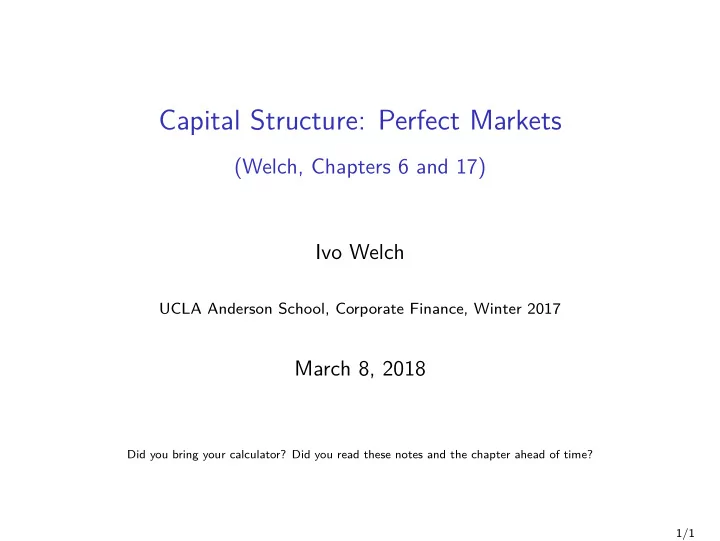

Capital Structure: Perfect Markets (Welch, Chapters 6 and 17) Ivo Welch UCLA Anderson School, Corporate Finance, Winter 2017 March 8, 2018 Did you bring your calculator? Did you read these notes and the chapter ahead of time? 1/1
Main Example ◮ Perfect Markets: No Taxes. No X-Costs. No Disagreements. Competitive Markets. ◮ With Prob 1/4, your firm will be worth $60 next year. ◮ With Prob 3/4, your firm will be worth $100 next year. ◮ The world is risk-neutral and all interest rates are 20%. (Will be relaxed later.) ◮ QUESTION: If you wanted to finance the firm with debt and equity, what interest rate do you have to promise to raise $70 in debt today? We assume the debt is really due and cannot be delayed, but that we can just sell the firm instantly at its value with any other capital structure. We also assume that there is no liquidity vs. value issue. Because we are in a perfect market, these assumptions are innocuous. 2/1
The world is risk-neutral and interest rates are 20%. With Prob 1/4, your firm will be worth $60 next year. With probability 3/4, it will be worth $100. What interest rate do you have to promise to raise $70 in debt today? $70 is not the face value of debt, but what you get today. 3/1
In a perfect market, if the value of the firm was $76 under the debt-laden capital structure (say, $70+$6), but the managers chose the $75 capital structure (say, all equity), what would you do? 4/1
In a perfect market, if the value of the firm was $74 under the debt-laden capital structure (say, $69+$5), and the managers chose the $74 capital structure, what would you do? 5/1
How does the value of the firm depend on the value of debt and equity? 6/1
Which share of debt or equity maximizes firm value? 7/1
Let’s Complicate the World No more risk-neutrality Shake and repeat 8/1
Main Example ◮ Perfect Markets: No Taxes. No X-Costs. No Disagreements. Competitive Markets. ◮ With Prob 1/4, your firm will be worth $60 next year. ◮ With Prob 3/4, your firm will be worth $100. ◮ The world is NOT risk-neutral. ◮ The interest rate for projects as risky as the firm is 20%. This does not apply to debt or equity. ◮ Your I-Banker tells you that you can raise $65 if you promise a rate of return of 16.92% ◮ QUESTION: What is your cost of equity? Your cost of debt? Your leverage ratio? We assume the debt is really due and cannot be delayed, but that we can just sell the firm instantly at its value with any other capital structure. We also assume that there is no liquidity vs. value issue. Because we are in a perfect market, these assumptions are innocuous. 9/1
The firm still has a cost of capital of 20%. However, now the market tells you that you can raise $65 if you promise a rate of return of 16.92%. What is your expected rate of return on the two claims (debt and equity)? 10/1
What is the WACC of the debt+equity capital structure? 11/1
If only $0.01 in debt had been promised, what would have been the riskiness of debt and equity? 12/1
Which share of debt or equity maximizes firm value? 13/1
How does the cost of capital (and risk) of the debt depend on the firm’s leverage ratio? 14/1
How does the cost of capital (and risk) of the equity depend on the firm’s leverage ratio? 15/1
If the cost of capital (and risk) of equity goes up and the cost of capital (and risk) of debt goes up, and the firm consists only of debt and equity, does the cost of capital (and risk) of the firm go up? 16/1
How does the cost of capital (and risk) of the firm depend on the firm’s leverage ratio? 17/1
In the above example ($65 debt), for fun, calculate the riskiness of the two claims and what is the riskiness of the firm? 18/1
Example With Normally Distributed Payoffs 100 80 Rate of Return, in % 60 40 d t e e c x p , E i t y q u E WACC 20 d s e m i o r P d , o n B Bond, Expected 0 0 20 40 60 80 100 Debt Ratio, in % Note that the promised rate of return on debt can be above the WACC! Note that for reasonable debt ratios (say, 0% tp 60%), the cost of the firm’s debt really remains the same. 19/1
Recommend
More recommend